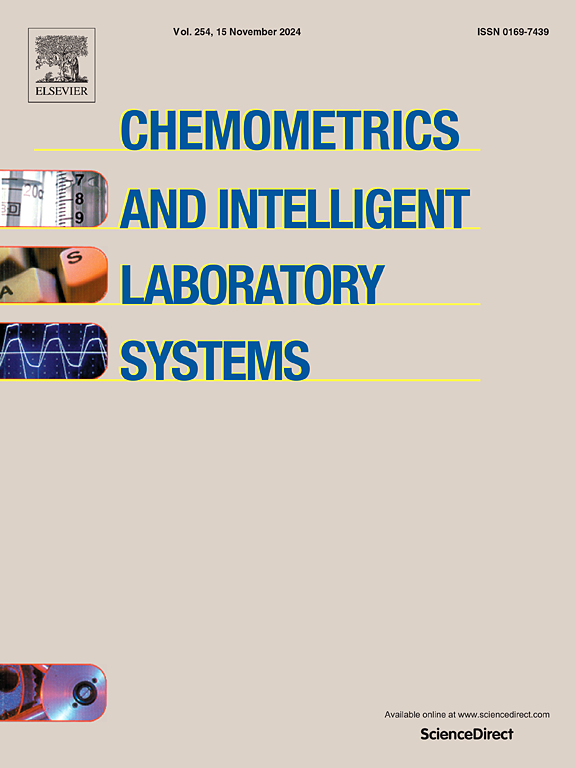多特征融合和混合与条件解码器
IF 3.8
2区 化学
Q2 AUTOMATION & CONTROL SYSTEMS
Chemometrics and Intelligent Laboratory Systems
Pub Date : 2025-09-12
DOI:10.1016/j.chemolab.2025.105534
引用次数: 0
摘要
近年来,振动光谱数据与数据驱动相结合的方法主导了近距离光谱识别的发展和应用。然而,在实际应用中,可能会遇到开放的光谱类别(即新的/未知的光谱类别),因为收集全面的光谱类别耗时且需要专业知识。直观的解决方案是模糊不同类别的特征,但相关探索性实验的开集性能不理想,这可能是由于谱特征稀疏和类间相似度高。为了解决这一问题,本文创新性地提出了一种将多特征融合和混合与条件解码器(MFFMCD)相结合的端到端方案。为了增强特征表征,MFFMCD采用了两个辅助特征提取模块,融合了不同分支特征。此外,为了应对高类间相似性,增强的特征被模糊在一个小批中,并通过条件解码器恢复到相应的类样本中,以模拟未知类的特征分布。在三个公开的光谱数据集上的实验表明,所提出的MFFMCD显著优于现有的方法。最后,进行了广泛的消融研究,以调查我们的建议的有效性,正确性和稳健性。本文章由计算机程序翻译,如有差异,请以英文原文为准。
Multiple features fusion and mixup with conditional decoder for
In recent years, the combination of vibration spectral data and data-driven methods has dominated the development and application of close spectral recognition. Nevertheless, in practical applications, open spectral categories (i.e., novel/unknown spectral categories) may be encountered, as collecting comprehend-sive categories is time-consuming and requires professional expertise. The intuitive solution is to obscure features of different categories, but relevant exploratory experiments yield unsatisfactory open-set performance, which may be attributed to sparse spectral features and high inter-class similarity. To remedy this issue, we innovatively propose an end-to-end scheme combining Multiple Features Fusion and Mixup with Conditional Decoder (MFFMCD) in this paper. In particular, to enhance feature representation, MFFMCD adopts two auxiliary feature extraction modules and fuses different branch features. Additionally, to cope with high inter-class similarity, the enhanced features are obscured within a mini-batch and restored to corresponding class samples through a conditional decoder to mimic the feature distribution of unknown classes. Experiments on three publicly available spectral datasets show that the proposed MFFMCD significantly outperforms existing methods. In the end, extensive ablation studies are conducted to investigate the effectiveness, correctness, and robustness of our proposal.
求助全文
通过发布文献求助,成功后即可免费获取论文全文。
去求助
来源期刊
CiteScore
7.50
自引率
7.70%
发文量
169
审稿时长
3.4 months
期刊介绍:
Chemometrics and Intelligent Laboratory Systems publishes original research papers, short communications, reviews, tutorials and Original Software Publications reporting on development of novel statistical, mathematical, or computer techniques in Chemistry and related disciplines.
Chemometrics is the chemical discipline that uses mathematical and statistical methods to design or select optimal procedures and experiments, and to provide maximum chemical information by analysing chemical data.
The journal deals with the following topics:
1) Development of new statistical, mathematical and chemometrical methods for Chemistry and related fields (Environmental Chemistry, Biochemistry, Toxicology, System Biology, -Omics, etc.)
2) Novel applications of chemometrics to all branches of Chemistry and related fields (typical domains of interest are: process data analysis, experimental design, data mining, signal processing, supervised modelling, decision making, robust statistics, mixture analysis, multivariate calibration etc.) Routine applications of established chemometrical techniques will not be considered.
3) Development of new software that provides novel tools or truly advances the use of chemometrical methods.
4) Well characterized data sets to test performance for the new methods and software.
The journal complies with International Committee of Medical Journal Editors'' Uniform requirements for manuscripts.

 求助内容:
求助内容: 应助结果提醒方式:
应助结果提醒方式:


